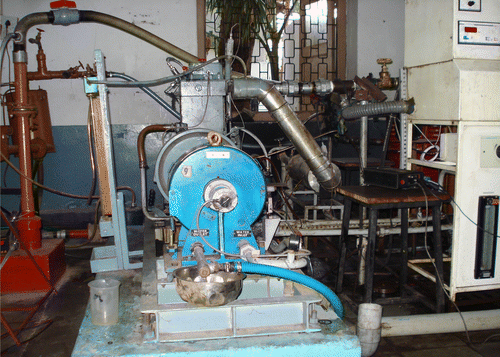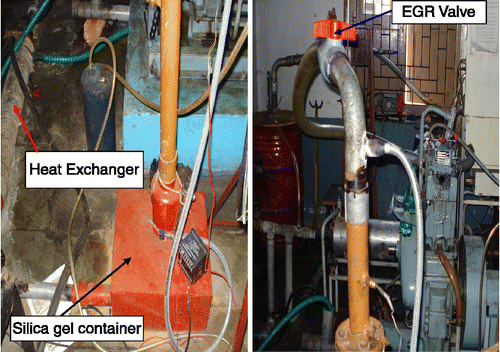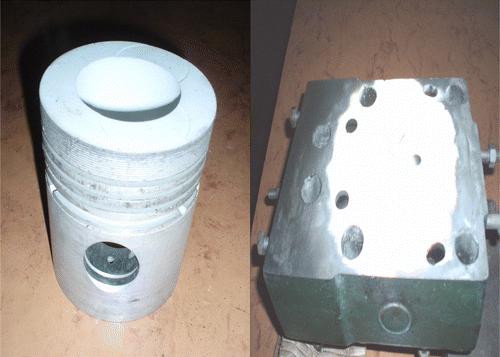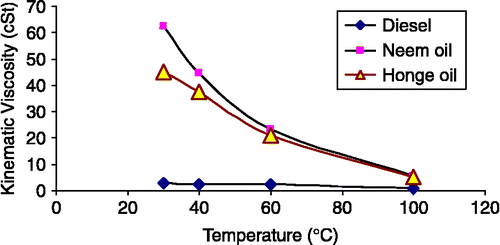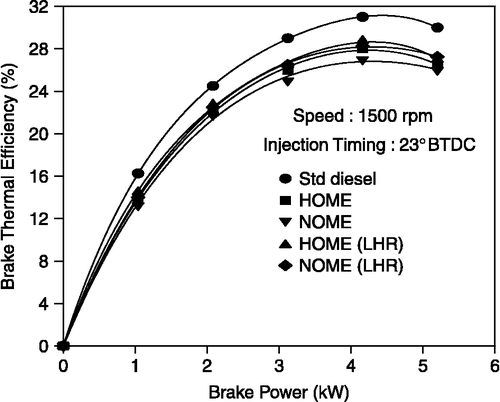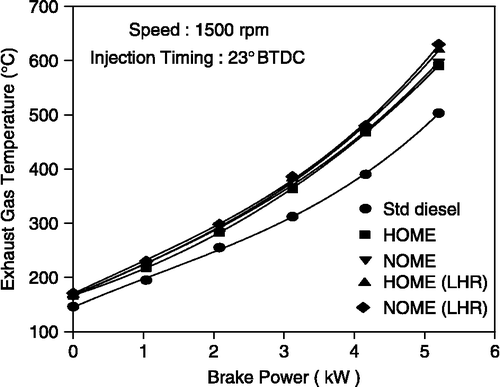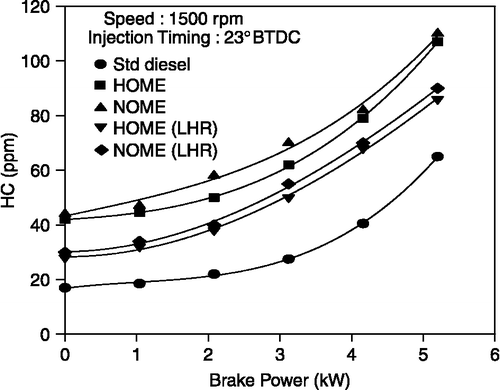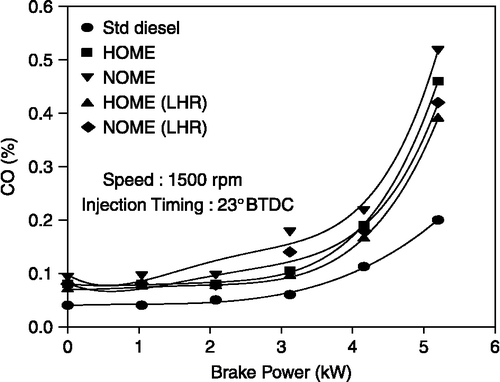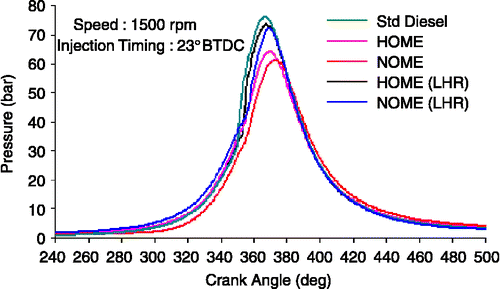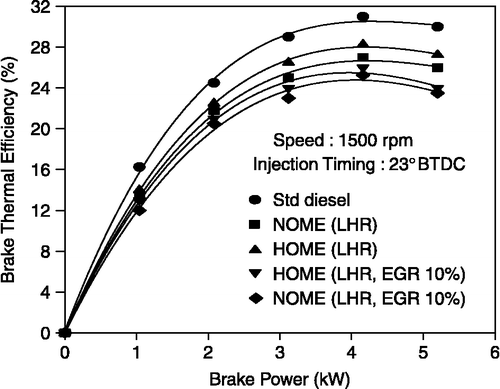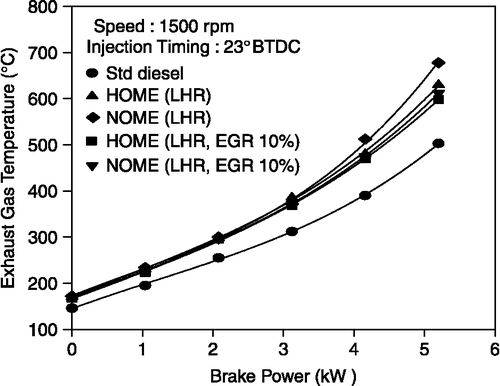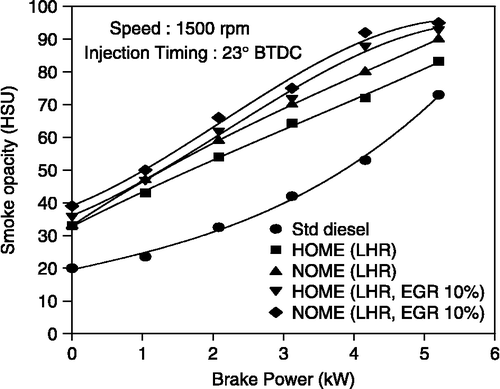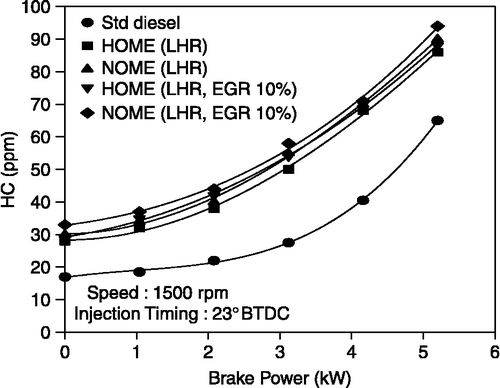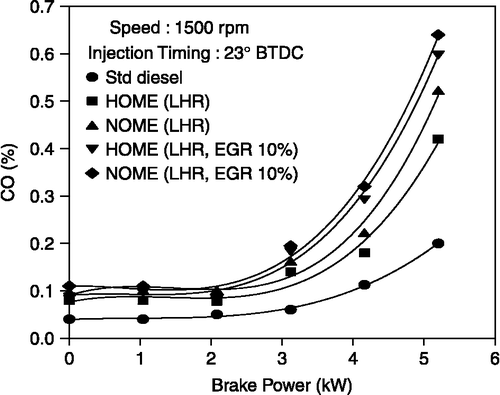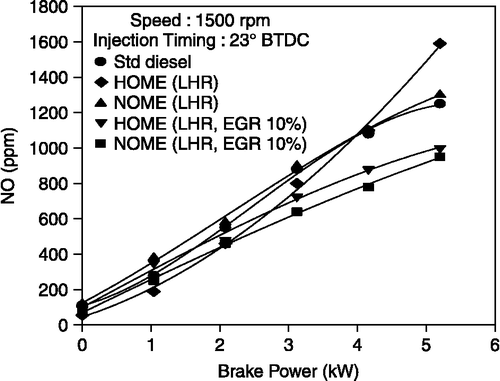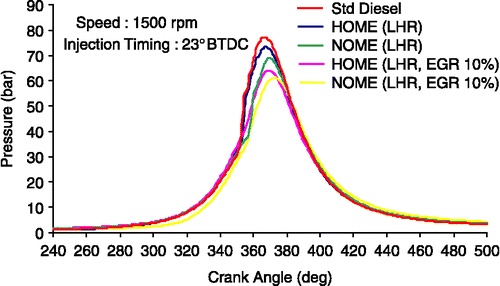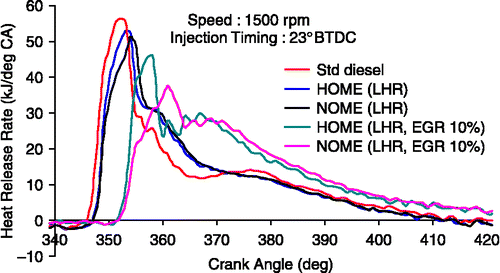Abstract
During recent decades, considerable effort has been expended world-wide to reduce dependency on petroleum fuels for power generation and transportation through the search for suitable alternative fuels that are environmentally friendly. In this respect, vegetable oils are a promising alternative to diesel fuel. However, the high viscosity, poor volatility and cold flow characteristics of vegetable oils can cause some problems such as injector coking, severe engine deposits, filter gumming and piston ring sticking and thickening of lubrication from long-term use in diesel engines. These problems can be eliminated or minimised by transesterification of the vegetable oils to form monoesters. Although transesterification improves the fuel properties of vegetable oil, the viscosity and volatility of biodiesel are still worse than those of petroleum diesel fuel. The performance of a diesel engine with such biodiesel operation can be improved further with the concept of the low heat rejection (LHR) engine. In the LHR engine, combustion surfaces on the pistons, cylinder walls and valves can be coated with ceramic materials. The objective of this study was to apply the LHR engine concept for improving engine performance when either honge biodiesel, known as honge oil methyl ester (HOME), or neem biodiesel, known as neem oil methyl ester (NOME) oils was used as an alternative fuel. For this purpose, experiments were conducted on a single cylinder, four-stroke, direct injection, water-cooled compression ignition engine using diesel, HOME and NOME oils at different injection timings of 19, 23 and 27° before top dead centre (BTDC) with and without the induction of exhaust gas recirculation (EGR). The percentage of EGR was varied from 5 to 20% in steps of 5%. The results showed that specific fuel consumption and brake thermal efficiency were improved for both of the biodiesel fuels in the LHR engine. An EGR of 10% resulted in better performance with trade-off between oxides of nitrogen and hydrocarbons/carbon monoxide emissions and hence 10% EGR is taken as the best of the range from 5 to 20%. However, readings with other EGR ratios are not reported.
1. Introduction
Diesel engines play a major role in transportation, industrial power generation and in the agricultural sector. Although the cost of crude oil has fallen from its 2008 peak, a return to worldwide economic growth is likely to lead to an increase in both demand and cost. During 2008, India's monthly cost of imported oil averaged $US 7.7 billion. In view of the growing demand and high cost of fossil fuels, and the associated global warming emissions, the search for fuels that are preferably renewable, clean burning and with low emission is gaining momentum (Vellguth Citation1983, Scholl and Sorenson Citation1993, Recep et al. Citation2000, Narayana Reddy and Ramesh Citation2005, Agarwal and Agarwal Citation2007). Vegetable oils, like honge and neem oils, are available in rural areas and have a high cetane number and a calorific value that is quite close to that of diesel. The difficulties associated with using raw vegetable oils in diesel engines are injector coking, severe engine deposits, filter gumming problems, piston ring sticking, and injector coking, and thickening of the lubricating oil (Vellguth Citation1983, Scholl and Sorenson Citation1993, Recep et al. Citation2000, Narayana Reddy and Ramesh Citation2005, Agarwal and Agarwal Citation2007). The high viscosity and low volatility of raw vegetable oils are generally considered to be the major drawbacks for their utilisation as fuels in diesel engines. These effects can be eliminated or reduced through transesterification of the oils to form monoesters. These monoesters are known as biodiesel and have improved cetane number and heating value (Perkins et al. Citation1991, Monyem and Van Gerpen Citation2001, Demirbas Citation2007).
The low heat rejection (LHR) engine was conceived to improve fuel economy by converting part of the exhaust energy into shaft work. Many studies have been conducted on the performance, structure and durability of the LHR engine (Coers et al. Citation1984, Wade et al. Citation1984, Amman Citation1988, Alkidas Citation1989, Sun et al. Citation1993, Kamo et al. Citation1999, Jaichandar and Tamilporai Citation2003, Ekrem et al. Citation2006). Most concluded that insulation reduces heat transfer, improves thermal efficiency and increases energy availability in the exhaust. Thermal barrier coatings are becoming important for thermal insulation of LHR engine components. Different materials such as silicon carbide, silicon nitride, aluminium magnesium silicate and other ceramic materials have been used. Partially stabilised zirconium (PSZ) has been found to be quite desirable for an adiabatic engine application. This is because of its excellent insulating characteristics, strength and thermal expansion characteristics. It has been found that an increased thickness of plasma-sprayed thermal barrier coatings normally leads to a reduced coating life time and this requires modification of the coating structure. In this respect, several investigators have studied the characterisation of modified thick thermal barrier coatings (Kamo et al. Citation1999, Ahmaniemi et al. Citation2004). Increased cylinder temperatures will allow LHR engine operation with a wider range of fuels. Higher temperatures in the combustion chamber can also have a positive effect on diesel engines due to the self-ignition delay drop (Alkidas Citation1989, Ekrem et al. Citation2006). This is because the hot combustion wall temperatures of an adiabatic engine provide higher compression charge temperatures with reduced ignition delay. The power output of the LHR engine increases with increased thermal efficiency and decreased specific fuel consumption (Wade et al. Citation1984, Jaichandar and Tamilporai Citation2003). The LHR engine suffers significantly from a loss of volumetric efficiency (Wade et al. Citation1984). Some investigations have shown that exhaust emissions decrease owing to the higher combustion temperature. Exhaust emissions and fuel economy should be considered together. The regulated emissions include unburned hydrocarbons (HC), carbon monoxide (CO), oxides of nitrogen (NO x ) and exhaust particulates or smoke in some cases. Because the diesel engine employs an overall lean stoichiometric ratio, CO is not a potential problem. A review of the limited published data on measured emissions from LHR diesel engines shows that while there are instances where HC did decrease, there are others where it increased (Amman Citation1988). Most of the earlier investigations show that NO x emissions from LHR engines are generally higher (Alkidas Citation1989) than those for water-cooled engines. In a LHR diesel engine, the insulation leads to an increase in combustion temperatures compared to an identical standard diesel engine (Amman Citation1988). Alkidas (Citation1989) observed that diffusion burning is the controlling factor for NO x production. High combustion temperatures alter optimum injection timing of a LHR engine. With proper adjustment of the injection timing (Alkidas Citation1989), it is possible to partially offset the adverse effect of insulation on heat release rate and hence to obtain improved performance and lower NO x . However, the injection timing and brake specific fuel consumption trade-off must be considered together from both performance and NO x emission viewpoints. Various methods for reducing diesel engine NO x emissions have been adopted such as retarding the fuel injection timing, lowering the intake temperature, water injection emulsification of the fuel, exhaust gas recirculation (EGR) and lower compression ratio (Gros Citation1991, Ladommatos et al. Citation1998, Abd Alla Citation2001, Yoshimoto and Tamoki Citation2001, Tomazic and Pfeifer Citation2002, Agarwal and Singh Citation2004, Agarwal et al. Citation2005, Peng et al. Citation2008). Such methods may reduce nitric oxide but may increase particulate emissions at high loads. Hence, there is trade-off between nitric oxide and smoke emission. It is essential to use a particulate trap to reduce the amount of unburned particulates with EGR operation, especially when using vegetable oils. Ignition delay is shorter in LHR engines; a decreased premixed fraction with an increase in the amount of fuel burnt during the diffusion phase of combustion has been reported (Ladommatos et al. Citation1998, Tomazic and Pfeifer Citation2002).
In the present work, the engine combustion chamber elements such as piston, cylinder head and valve faces were coated with PSZ (400 μm) to obtain an LHR engine. The objective of this study was to assess the application of LHR engine technology for the improvement of engine performance when biodiesel was used as an alternative fuel. For this purpose, experiments were conducted on a single cylinder, four-stroke, direct injection, water-cooled compression ignition (CI) engine with biodiesel at optimised injection timings, with and without the introduction of 10% EGR. Even though experiments were also conducted with other EGR ratios of 5, 15 and 20%, these readings are not reported in the present work.
2. Fuel properties
The properties of honge oil methyl ester (HOME) and neem oil methyl ester (NOME) oils were determined using Bureau of Indian Standards procedures and they are summarised in Table .
Table 1 Properties of diesel, honge and neem oil (Agarwal et al. Citation2005, Banapurmath et al. Citation2005, Citation2008, Peng et al. Citation2008).
2.1 Availability and economic value of oils
India has rich and abundant resources of both edible and non-edible oil seeds. However, methyl/ethyl esters produced from edible oils are much more expensive than diesel oil. This is because vegetable oils are about four times the cost of diesel. There is a need, therefore, to identify alternative feed stocks for the production of biodiesels. Non-edible oils, from sources such as honge and neem, are readily available in many parts of India and they are cheap when compared to edible oils. The honge tree is indigenous throughout India from the foothills of the Himalayas down to the south of the Peninsula. Honge trees can grow on most moist soil types and it is highly tolerant to salinity. The neem tree is considered to be a wonder tree in the Indian sub continent. Its fruits ripen during June–August and the life period of a tree is 50–60 years and the seeds contain up to 45% of oil (Barnwal and Sharma Citation2005, Agarwal Citation2006).
The price of crude petroleum and the cost of transporting diesel for long distances to remote markets play a key role in evaluating economical feasibility of biodiesel. Although, as stated, the cost of producing methyl/ethyl esters from edible oils is expensive; the cost of biodiesel can be reduced if non-edible oils are used (Agarwal Citation2006). Barnwal and Sharma (Citation2005) have presented the economic feasibility of different vegetable oils including edible and non-edible oils. The realisation of using these locally available vegetable oils as a sustainable, alternative fuel to diesel could pave the way to improved energy security for India.
3. Experimental heat release rate estimation
The heat release rate of the fuel causes a variation of gas pressure and temperature within the engine cylinder. It strongly affects fuel economy, power output and the emissions of the engine (Aman Citation1985, Heywood Citation1988, Rocco Citation1993, Samuel and Atreya Citation1997, Michael and Kieron Citation1999). In-cylinder pressure and top dead centre signals were acquired and stored using a high-speed, computer-based, digital data acquisition system. The data from 100 consecutive cycles were recorded. The heat release rate was calculated by using a first law analysis of the pressure crank angle data. Net heat release rates were calculated using a single zone heat release model (Heywood Citation1988).
4. Experimental setup
Figure shows the schematic diagram of the complete experimental engine test rig with EGR arrangement. The engine tests were conducted on a single cylinder four-stroke, naturally aspirated, open chamber (direct injection) water-cooled CI engine. The specifications of the engine are presented in Table . In order to run the existing diesel engine on non-edible oils with EGR, some minor modifications were required. The EGR arrangement includes an air intake system with connections between the EGR system and the air intake system. The exhaust pipe, after the calorimeter, is divided into two passages: one is connected to the inlet of the silica gel container (for removing moisture from the exhaust gas); and the second is open to atmosphere. The outlet of the silica gel container is connected to the air intake system which consists of a filter material. To control the EGR rate, two valves were provided: one between the calorimeter exhaust outlet and inlet to the silica gel container; and the second between the outlet of the silica gel container and the inlet of the air intake system. Figure shows the EGR details. The experiments were conducted, for all the injected fuels, at 0, 5, 10, 15 and 20% of EGR flow rates and results for 10% EGR are only reported.
Table 2 Specifications of the engine.
The engine was operated at a rated speed of 1500 r/min and had a conventional fuel injection system. The injection nozzle had three holes of 0.3 mm diameter with a spray angle of 120°. The injector opening pressure and the static injection timing were those specified by the engine manufacturer: 205 bar and 23° BTDC, respectively. Engine cooling was accomplished by circulating water through the engine block and cylinder head jackets. The cooling water outlet temperature was kept at a constant temperature of 60°C during the tests. A piezoelectric pressure transducer was mounted flush with the cylinder head surface to measure the cylinder pressure. Exhaust gas opacity was measured using a Hartridge smoke opacity meter. The exhaust gas composition was measured using an exhaust gas analyser (Make: MRU, Model: Delta 1600S). The emissions measured were: CO2, CO, HC, nitric oxide (NO) and O2. The basic principle for measurement of CO2, CO, HC and NO emissions was non-dispersive infrared technology and an electrochemical method was used for NO and oxygen measurement. Figure shows the LHR piston and cylinder head coated with PSZ to produce the LHR engine option.
5. Results and discussions
5.1 Effect of temperature on kinematic viscosity of fuels tested
The effect of temperature on the kinematic viscosity of honge oil and neem oil is shown in Figure . The higher kinematic viscosity of the vegetable oils tested in comparison to diesel may be attributed to the greater intermolecular attraction of the long chains of their glyceride molecules and fatty esters, respectively. It was observed that viscosity decreased with an increase in temperature. The kinematic viscosity of honge and neem oil was found, respectively, to be 17.94 and 30 times more than that of diesel determined at 40°C.
The performance, emission and combustion characteristics of the LHR engine under variable load conditions were compared at 23° BTDC injection timings with and without the EGR arrangement for the injected fuels of HOME, NOME and diesel. The results for the LHR engine operated on HOME and NOME oils, with and without 10% EGR, are presented and analysed in the following sections.
5.2 Operation without EGR induction
5.2.1 Performance parameters
The effect of brake power on brake thermal efficiency for HOME and NOME is shown in Figure . There is a steady increase in brake thermal efficiency as load increases. It was observed that the brake thermal efficiency of the engine was lower for the entire load range for HOME/NOME oil operation compared to diesel operation. This is due to poor mixture formation as a result of the lower volatility, higher viscosity and density of the HOME and NOME oils.
The objective of LHR engine operation is to improve the performance of the engine with reference to brake thermal efficiency. This is evident from the observed maximum brake thermal efficiency values of 29.51%, and 28.00% for HOME and NOME oils, respectively, with LHR operation as compared to 28.00 and 27.00%, respectively, for non-LHR operation at 80% power output. This is attributed to in-cylinder heat transfer reduction and a lower heat flux. However, the maximum brake thermal efficiency for diesel operation was observed to be 31.00%.
The effect of brake power on exhaust gas temperature (EGT) for HOME and NOME oils is shown in Figure . The EGT was higher for the LHR engine than for the conventional engine operation and it was higher for HOME and NOME oils than for diesel, particularly at higher loads. The poor volatility and higher viscosity of these biofuels led to a more dominant diffusion combustion phase than for diesel, which is responsible for this. Also, the late burning of injected HOME and NOME oils resulted in slower combustion and this, in turn, resulted in higher EGT. The maximum EGT at peak load with LHR engine operation was 470 and 480°C, respectively, for HOME and NOME oils. The observed peak EGT was 390°C for diesel operation.
5.2.2 Emission parameters
The effect of brake power on smoke opacity for HOME and NOME oils is shown in Figure . Owing to their heavier molecular structure and higher viscosity, atomisation becomes poor and this leads to higher smoke emission. However, LHR engine operation produced less smoke than standard engine operation owing to enhanced soot oxidation, which is the result of higher gas and combustion chamber wall temperatures. Smoke levels at 80% power output were 70 and 72 HSU, respectively, for HOME and NOME oils, whereas that for diesel was 53 HSU.
The effect of brake power on hydrocarbon emissions for HOME and NOME oils is shown in Figure . The poor mixture formation tendency of HOME and NOME leads to higher hydrocarbon levels compared to standard diesel operation. The lower thermal efficiency of the engine with these oils is also responsible for this trend. When thermal efficiency is lower there is a need to inject higher quantities of fuel for the same load condition. The emission of unburned hydrocarbon is reduced with LHR engine because of the decreased quenching distance and increased lean flammability limit. The higher temperatures of the combustion chamber walls in LHR engine operation enable oxidation reactions to proceed closer to their completion. The HC emission levels at 80% load during LHR engine operation were 68 and 70 ppm with HOME and NOME oils, respectively, compared to 79 and 82 ppm, respectively, for conventional engine operation.
The effect of brake power on CO levels for HOME and NOME oils is shown in Figure . The CO emission is reduced with LHR engine operation for reasons that are similar to those for unburned hydrocarbon. This is attributed to the higher temperature of burnt gases and combustion chamber walls. The reduced pre-mixed combustion level in the LHR engine reduces the initial production of CO and the higher temperatures during diffusion combustion accelerate the oxidation of CO. CO emission values were lower for diesel oil than for HOME or NOME oils and this could be related to the fuel viscosity effect. The trends suggest that the combustion efficiency decreases with HOME and NOME oils. This could be due to the poor spray characteristics of these fuels resulting in poor mixing and, consequently, poor combustion. The CO emission levels at 80% load with LHR engine operation were 0.165 and 0.18% with HOME and NOME oils in comparison to standard engine operation which produced levels of 0.19 and 0.22%, respectively, for these oils.
The effect of brake power on NO levels for HOME and NOME oils is shown in Figure . HOME and NOME oils show lower NO emission compared to diesel in standard engine operation. This reduction in NO emission is mainly associated with reduced premixed burning rate following the delay period. It may be noted that the rate of heat release during the premixed burning phase is lower with HOME and NOME oils when compared to diesel even though the ignition delay is higher. With LHR engine operation, the NO emissions for HOME and NOME oils were generally higher than those for standard engine operation. This was due to the higher combustion temperatures. The NO emission levels, at 80% load for LHR engine operation, were 1100 and 1200 ppm, respectively, for HOME and NOME oils in comparison to 990 and 780 ppm, respectively, for the standard engine operation.
Figure shows the variation in pressure with crank angle for HOME and NOME oils. It was observed that the peak pressure increases for HOME and NOME oils and that combustion started later in comparison to diesel fuel in both LHR and standard engine operation.
5.3 Operation with EGR induction
5.3.1 Performance parameters
Figure shows the effect of brake power on brake thermal efficiency levels for HOME and NOME oils with LHR operation. It can be seen that, with 10% EGR induction, the brake thermal efficiency reduced with an increase in brake power. This is because there is deterioration in combustion when 10% EGR is introduced and the gaseous fuel–air mixture becomes diluted with exhaust gas. The introduction of 10% EGR reduces the rates of auto ignition reactions, as indicated by an increase in the ignition delay period. The premixed combustion fraction increases and causes a delay in the whole diffusive combustion event with 10% EGR, because a larger amount of fuel is injected during the longer ignition delay period. A retarded combustion event, due to an extended ignition delay, will generally impair fuel economy, thus requiring timing adjustments that offset the benefit of NO x emission reduction (Ladommatos et al. Citation1998, Tomazic and Pfeifer Citation2002). Deterioration in the air–fuel mixture reduces the oxygen concentration and this leads to incomplete combustion. Although the presence of oxygen in vegetable oils compensates for oxygen deficiency, their lower calorific value and higher density lead to reduced brake thermal efficiency.
The effect of brake power on EGT for HOME and NOME oils with LHR operation is shown in Figure . The figure shows that the temperature of the exhaust gas decreased with a 10% EGR induction. This effect is caused by a dilution of the amount of oxygen available for combustion that reduces combustion temperature and, consequently, EGT.
5.3.2 Emission parameters
The effect of brake power on smoke opacity for standard diesel operation, and HOME and NOME oils with LHR operation, is shown in Figure . It was observed that smoke emission was higher for the HOME and NOME oils than for standard diesel operation. This may be due to the heavier molecular structure, higher viscosity and presence of higher free fatty acids in the vegetable oil. The smoke opacity for HOME and NOME oils was even higher with 10% EGR induction. This negative effect of EGR on smoke opacity could be due to the reduction of the engine air–fuel ratio.
The effect of brake power on HC emission is shown in Figure and it can be observed that HC emissions are comparatively higher for HOME and NOME oils. With the 10% EGR induction, the combustion degradation lowers the temperature. The decreased air–fuel ratio associated with EGR induction and reduced combustion temperature results in incomplete fuel combustion. These factors may lead to the higher HC emissions.
Figure shows the effect of brake power on CO emissions. CO is comparatively low for standard engine operation with diesel. For the LHR operation with HOME and NOME oils, 10% EGR induction dilutes the combusting mixture. Therefore, insufficient oxygen is available for better combustion and the lower combustion temperature prevailing in the engine cylinder leads to comparatively higher CO emissions.
Figure shows the effect of brake power on NO emissions. The lowest values were obtained with HOME and NOME oils used in the LHR engine with 10% EGR induction. EGR appears to reduce the adiabatic flame temperature and, thereby, the combustion temperature and hence NO emissions are reduced. Therefore, NO concentration decreases as CI engine inlet air flow is diluted at a constant fuelling rate.
Figure shows the variation of pressure with crank angle for HOME and NOME oils in the LHR engine with and without 10% EGR. It can be observed that the peak pressure for HOME and NOME oils in the LHR engine with 10% EGR induction is reduced when compared to LHR engine operation without EGR.
Figure compares heat release rates at 80% load. The premixed burning phase associated with a high heat release rate is significant for standard diesel operation and is responsible for the higher peak pressure and higher rates of pressure rise. This is the reason for the higher thermal efficiency with diesel. In both modes of LHR engine operation, i.e. with and without 10% EGR induction, the significantly higher combustion rates during the later stages with HOME and NOME oils lead to higher exhaust temperatures and lower thermal efficiency. The LHR engine operation results in reduced heat release rates.
6. Conclusions
| 1. | LHR operation with HOME and NOME produced an improvement in brake thermal efficiency when compared with standard engine operation. However, this improvement did not match the standard diesel-only engine operation. The brake efficiency values were: 29.51 and 28.00%, respectively, for HOME and NOME with LHR; compared to 28.00 and 27.00% without LHR. The value for standard diesel-only operation was higher at 31.00%. | ||||
| 2. | EGT increased with an increase in brake power for all fuel and engine conditions. The lowest values of EGT were obtained with standard diesel-only engine operation and the highest values were observed for HOME and NOME under LHR engine operation. | ||||
| 3. | Although the values for smoke, HC and CO were higher for HOME and NOME operation, compared with standard diesel-only operation; LHR engine operation reduced the values. | ||||
| 4. | LHR operation with HOME and NOME appeared to produce higher NO levels than standard engine operation, although standard diesel-only operation did not produce the lowest NO levels. For example, at 80% load the NO values for LHR operation were 1100 and 1200 ppm for HOME and NOME, respectively, compared to 990 and 780 ppm for standard engine operation. | ||||
| 5. | Heat release rate was better for HOME when compared with the NOME oil operation, which resulted in improved brake thermal efficiency. This is substantiated in Figure in which more injected HOME burns in the premixed burning phase than diffusion combustion phase when compared with NOME. | ||||
| 6. | Compared with the neat diesel operation, HOME and NOME oils resulted in poor engine performance associated with increased emissions in both versions of with and without EGR. | ||||
| 7. | Cold EGR of 10% effectively reduced NO emission for HOME and NOME oils, respectively. With increasing EGR ratios beyond 10% resulted in lower NO but at the same time HC/CO emissions increased drastically. | ||||
| 8. | Heat release rate was better for HOME and NOME oils in LHR engine without EGR when compared with the EGR rate of 10%. The LHR engine operation with HOME and NOME resulted in an increase in the proportion of premixed combustion owing to shortening of the ignition delay with a corresponding decrease in the proportion of diffusion combustion compared with HOME and NOME operation with 10% EGR. | ||||
In summary, it was observed that LHR engine operation with HOME and NOME oils resulted in slightly improved brake thermal efficiency, reduced smoke, lower levels of HC and CO emissions and increased NO emissions when compared with standard engine operation. Heat release rates indicate a short premixed heat release portion in spite of an increase in ignition delay. The NO emissions were significantly (28%) reduced with 10% EGR induction. However, the overall performance with 10% EGR was poor due to increased smoke, HC and CO emissions.
References
- Abd Alla , G.H. 2001 . Using exhaust gas recirculation in internal combustion engines. A review . Journal on Energy Conservation and Management , 43 (8) : 1027 – 1042 .
- Agarwal , A.K. 2006 . Biofuels (alcohols and biodiesel) applications as fuels for internal combustion engines . International Journal of Progress in Energy and Combustion Science , 33 : 233 – 271 .
- Agarwal , D. and Agarwal , A.K. 2007 . Performance and emission characteristics of a jatropha oil (preheated and blends) in a direct injection compression ignition engine . Journal of Applied Thermal Engineering , 27 : 2314 – 2323 .
- Agarwal , A.K. and Singh , S.S. 2004 . Effect of EGR on the exhaust gas temperature and exhaust opacity in CI engine . Sadhana , 29 ( 3 ) : 275 – 284 .
- Agarwal , D. , Agarwal , A.K. and Sinha , S. 2005 . Experimental investigation of control of NOx emissions in biodiesel fuelled compression ignition engine . Journal of Renewable Energy , 31 (4) : 2356 – 2369 .
- Ahmaniemi , S. 2004 . Characterization of modified thick thermal barrier coatings . Journal of Thermal Spray Technology , 13 ( 3 ) : 361 – 369 .
- Alkidas, A.C., 1989. Performance and emission with an un cooled heavy-duty single-cylinder diesel engine. SAE paper 890144, USA
- Aman, C.A., 1985. Cylinder pressure measurement and its use in engine research. SAE paper 852067, USA
- Amman , C.A. 1988 . Promises and challenges of the low-heat-rejection diesel . Journal of Engineering for Gas Turbines and Power , 110 : 475 – 481 .
- Banapurmath , N.R. , Tewari , P.G. and Basavarajappa , Y.H. 2005 . “ Performance of honge (Pongamia pinnata) oil blends in a diesel engine ” . In XIX NCICEC , Chidambaram : Annamalai University .
- Banapurmath , N.R. , Tewari , P.G. and Hosmath , R.S. 2008 . Performance and emissions characteristics of a DI compression ignition engine operated on honge, jatropha and sesame oil methyl esters . Journal of Renewable Energy , 33 ( 9 ) : 1982 – 1988 .
- Barnwal , B.K. and Sharma , M.P. 2005 . Prospects of biodiesel production from vegetable oils in India . International Journal of Renewable and Sustainable Energy Reviews , 9 : 363 – 378 .
- Coers, R.B., Fox, L.D. and Jones, D.J., 1984. Cummins uncooled 250 engines. In: SAE international congress and exposition, Michigan, February–March
- Demirbas , A. 2007 . Progress and recent trends in biofuels . Journal of Progress in Energy and Combustion Science , 33 : 1 – 18 .
- Ekrem , B. , Tahsin , E. and Muhammet , C. 2006 . Effects of thermal barrier coating on gas emissions and performance of a LHR engine with different injection timings and valve adjustments . Journal of Energy Conversion and Management , 47 : 1298 – 1310 .
- Gros , S. 1991 . Low emissions for ship machinery . The motor ship, special supplement , : 16 – 19 .
- Heywood , J.B. 1988 . Internal combustion engine fundamentals , Singapore : McGraw-Hill Book Co .
- Jaichandar, S. and Tamilporai, P., 2003. Low heat rejection engines – an overview. SAE paper 2003-01-0405, USA
- Kamo, R., et al., 1999. Injection characteristics that improve performance of ceramic-coated diesel engines. SAE paper 1999-01-0972, USA
- Ladommatos, N., et al., 1998. Effects of EGR on heat release in diesel combustion. SAE paper 980184
- Michael, F.J.B. and Kieron, P., 1999. Calculation of heat release rate in direct injection diesel engines. SAE paper 1999-01-0187
- Monyem , A. and Van Gerpen , J.H. 2001 . The effect of biodiesel oxidation on engine performance and emissions . Biomass Bioenergy , 20 : 317 – 325 .
- Narayana Reddy , J. and Ramesh , A. 2005 . Parametric studies for improving the performance of a jatropha oil-fuelled compression ignition engine . Journal of Renewable Energy , 31 : 1994 – 2016 .
- Peng , H. 2008 . Effects of EGR on combustion process of DI diesel engine during cold start . Frontiers of Energy and Power Engineering , 2 ( 2 ) : 202 – 210 . China
- Perkins, L.A., Peterson, C.L. and Auld, D.L., 1991. Durability testing of transesterified winter rapeseed oil as fuel in small bore, multi-cylinder, DI, CI engines. SAE paper 911764
- Recep , A. , Selim , C. and Huseyin , S.Y. 2000 . The potential of using vegetable oil fuels as fuel for diesel engines . Journal of Energy Conversion and Management , 42 : 529 – 538 .
- Rocco, V.D.I., 1993. Diesel engine in cylinder pressure data analysis under TDC setting error. SAE paper 930595, USA
- Samuel, C.H. and Atreya, A., 1997. An experimental heat release rate analysis of a diesel engine operating under steady state conditions. SAE paper 970889, USA
- Scholl, K.W. and Sorenson, S.C., 1993. Combustion analysis of soyabean oil methyl ester in a direct injection diesel engine. SAE paper 930934, USA
- Sun, X., et al., 1993. Experimental analysis and performance improvement of single cylinder direct injection turbocharged low heat rejection engine. SAE paper 930989, USA
- Tomazic, D. and Pfeifer, A., 2002. Cooled EGR – a must or an option for 2002/04. SAE paper 2002-01-0962, USA, 467–475
- Vellguth, G., 1983. Performance of vegetable oils and their monoesters as fuels for diesel engines. SAE paper 831358, USA
- Wade , W.R. 1984 . Fuel economy opportunities with an uncooled DI diesel engine . : 11 – 24 . IMechE/SAE paper C432, USA
- Yoshimoto, Y. and Tamoki, H., 2001. Reduction of NOx and smoke emissions in a diesel engine fuelled by biodiesel emulsion combined with EGR. SAE paper 2001-01-0649, USA, 467–475
